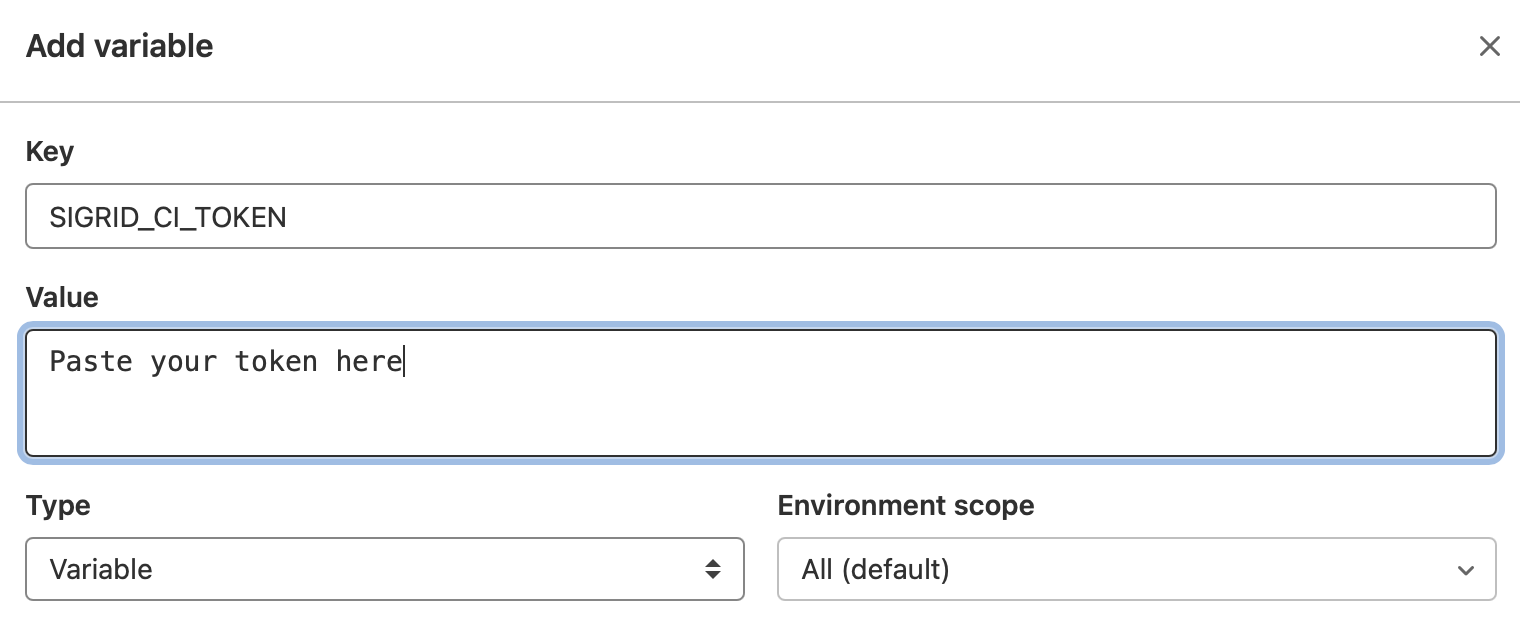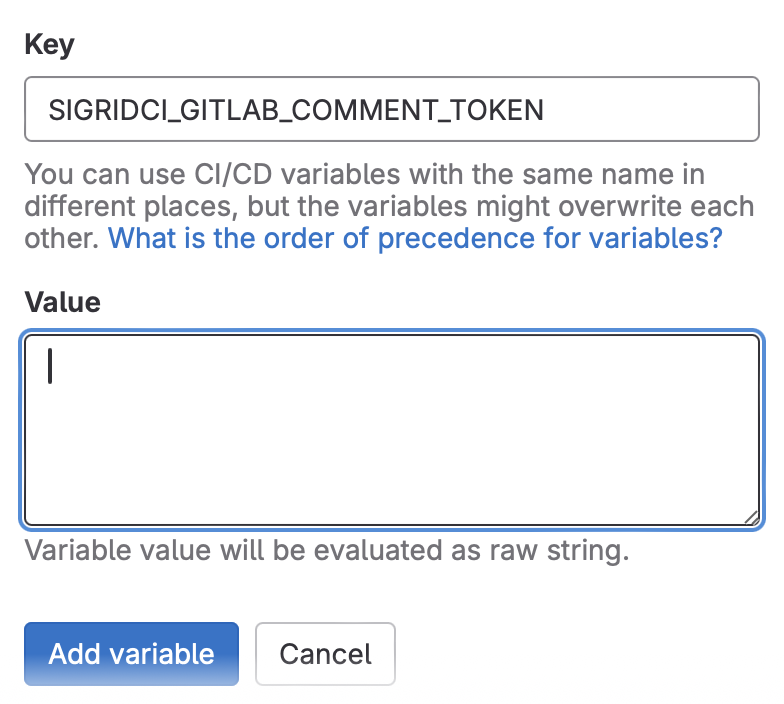Integrating Sigrid CI with GitLab
This documentation covers cloud-based Sigrid. For on-premise Sigrid, refer to the section about on-premise analysis configuration.
Prerequisites
- You have a Sigrid user account.
- You have created an authentication token for using Sigrid CI.
- Python 3.7 or higher needs to be available in the CI environment if you do not use the Docker image published by SIG. The client scripts for Sigrid CI are based on Python.
On-boarding your system to Sigrid
On-boarding a system is done automatically when you first run Sigrid CI for that system. As long as you have a valid token, you will receive the message system has been on-boarded to Sigrid. Subsequent runs will then be visible in both your CI environment and sigrid-says.com.
Configuration
Step 1: Configure Sigrid credentials to environment variables
Sigrid CI reads your Sigrid account credentials from an environment variable called SIGRID_CI_TOKEN. To add it to your GitLab CI pipeline, follow these steps:
- Select “Settings” in your GitLab project’s menu
- Select “CI/CD” in the settings menu
- Locate the section named “Variables”
- Click the “Add variable” button
- Add an environment variable
SIGRID_CI_TOKENand use your Sigrid authentication token as the value. Make sure the checkbox for “protect variable” is not checked, otherwise Sigrid CI will not be able to use the token.

These instructions describe how to configure a single GitLab project, but you can follow the same steps to configure the entire GitLab group, which will make the environment variables available to all projects within that group.
Next, create a token that is allowed to post merge request comments. Sigrid CI will use this token to share feedback directly within your merge request.
- Access your GitLab settings.
- Select the Access Token menu.
- Create a new token that has permission to access the API. Sigrid CI needs permission to use the API in order to post comments.
- This token needs to have sufficient rights to post merge request comments. What is considered “sufficient” depends on how your GitLab project is configured.

You now need to make this API token available to your pipeline. You can either do this in your project settings if you only want to provide access to a single project, or in the group settings if you want to use the same token for all projects and repositories in that group.

In your project and/or group settings, navigate to “CI/CD settings” and then pick “variables”. Next, add a variable called SIGRIDCI_GITLAB_COMMENT_TOKEN, and use the value from the previous step. Once you’ve added the token as a variable, it will automatically be picked up by Sigrid CI. Make sure the checkbox for “protect variable” is not checked, otherwise Sigrid CI will not be able to use the token.
Note: We realize it’s a bit cumbersome having to create the token and add it to a variable. There is a GitLab feature request that would allow integrations like Sigrid CI to post comments without needing their own special token. Once this is implemented in a future version of GitLab, Sigrid CI will be updated to no longer require manual creation of this token.
Step 2: Add Sigrid CI to your project’s CI pipeline
Next, you need to edit your project’s CI configuration, in order to add Sigrid CI as an extra step. There are two alternatives: use SIG’s Docker image (alternative 2.a below), or download and run the Sigrid CI Python script directly on your Gitlab runners (alternative 2.b below).
Both alternatives configure two additional build steps:
- The
sigridcijob provides Sigrid feedback for pull request. This step is configured to run for every branch except the main/master branch. - The
sigridpublishjob publishes project snapshots to sigrid-says.com. This step only runs for the main/master branch.
The relevant command that starts Sigrid CI is the call to the sigridci.py script, which starts the Sigrid CI analysis. The scripts supports a number of arguments that you can use to configure your Sigrid CI run. The scripts and its command line interface are explained in using the Sigrid CI client script.
Note that you need to perform this step for every project where you wish to use Sigrid CI.
Alternative 2a: Use SIG’s public Docker image
The recommended approach is to run Sigrid CI using the Docker image published by SIG. This requires using either the Docker or Kubernetes executor to be available on your GitLab runners.
Open .gitlab-ci.yml in your project’s root directory and add the following:
stages:
- report
sigridci:
stage: report
image:
name: softwareimprovementgroup/sigridci
script:
- sigridci.py --customer <example_customer_name> --system <example_system_name> --source . --capability maintainability,osh
allow_failure: true
artifacts:
paths:
- "sigrid-ci-output/*"
reports:
junit: "sigrid-ci-output/sigridci-junit-format-report.xml"
expire_in: 1 week
when: always
rules:
- if: $CI_PIPELINE_SOURCE == "merge_request_event"
sigridpublish:
stage: report
image:
name: softwareimprovementgroup/sigridci
script:
- sigridci.py --customer <example_customer_name> --system <example_system_name> --source . --publish
allow_failure: true
artifacts:
paths:
- "sigrid-ci-output/*"
expire_in: 1 week
when: always
rules:
- if: $CI_COMMIT_BRANCH == $CI_DEFAULT_BRANCH
Security note: This example pulls the latest version of SIG’s Sigrid CI Docker image directly from Docker Hub. That might be acceptable for many projects. However, some projects might not allow this as part of their security policy. In those cases, we recommend to either use alternative 2.b below, or clone SIG’s Docker image to your own image repository.
Alternative 2b: Download SIG’s Sigrid CI Python script
Alternative 2b does not use a Docker image. Instead, the Sigrid CI GitLab jobs download SIG’s Sigrid CI Python script directly from GitHub and runs it on your GitLab runner. This requires Github.com to be accessible from your CI environment and Python 3.7 to be available on your GitLab runners.
Sigrid CI consists of a number of Python-based client scripts, that interact with Sigrid in order to analyze your project’s source code and provide feedback based on the results. These client scripts need to be available to your GitLab runners, in order to call the scripts from the CI pipeline.
Open .gitlab-ci.yml in your project’s root directory and add the following:
stages:
- report
sigridci:
stage: report
script:
- git clone https://github.com/Software-Improvement-Group/sigridci.git sigridci
- ./sigridci/sigridci/sigridci.py --customer <example_customer_name> --system <example_system_name> --source . --capability maintainability,osh
allow_failure: true
artifacts:
paths:
- "sigrid-ci-output/*"
reports:
junit: "sigrid-ci-output/sigridci-junit-format-report.xml"
expire_in: 1 week
when: always
rules:
- if: $CI_PIPELINE_SOURCE == "merge_request_event"
sigridpublish:
stage: report
script:
- git clone https://github.com/Software-Improvement-Group/sigridci.git sigridci
- ./sigridci/sigridci/sigridci.py --customer <example_customer_name> --system <example_system_name> --source . --publish
allow_failure: true
artifacts:
paths:
- "sigrid-ci-output/*"
expire_in: 1 week
when: always
rules:
- if: $CI_COMMIT_BRANCH == $CI_DEFAULT_BRANCH
Security note: This example downloads the Sigrid CI client scripts directly from GitHub. That might be acceptable for some projects, and is in fact increasingly common. However, some projects might not allow this as part of their security policy. In those cases, you can simply download the sigridci directory in this repository, and make it available to your runners (either by placing the scripts in a known location, or packaging them into a Docker container).
Step 3: Analysis configuration
Sigrid will try to automatically detect the technologies you use, the component structure, and files/directories that should be excluded from the analysis. You can override the default configuration by creating a file called sigrid.yaml and adding it to the root of your repository. You can read more about the various options for custom configuration in the configuration file documentation.
Usage
Once you have configured the integration, Sigrid CI will show up as a new step in your GitLab CI pipeline. The step will succeed if the code quality meets the specified target, and will fail otherwise.

If you’ve followed these instructions, you will receive feedback from Sigrid on your merge request:

The feedback consists of the following:
- A list of refactoring candidates that were introduced in your merge request. This allows you to understand what quality issues you caused, which in turn allows you to fix them quickly. Note that quality is obviously important, but you are not expected to always fix every single issue. As long as you meet the target, it’s fine.
- An overview of all ratings, compared against the system as a whole. This allows you to check if your changes improved the system, or accidentally made things worse.
- The final conclusion on whether your changes and merge request meet the quality target.
Sigrid CI output is also included in GitLab’s CI/CD pipeline page, which contains a Tests tab. The View details button will show the same list of refactoring candidates that is shown in the aforementioned textual output and HTML report.
Contact and support
Feel free to contact SIG’s support department for any questions or issues you may have after reading this document, or when using Sigrid or Sigrid CI. Users in Europe can also contact us by phone at +31 20 314 0953.

